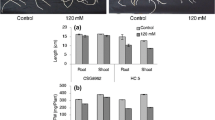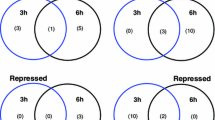Abstract
Salinity is a major abiotic stress, which reduces productivity of a broad range of crops, especially legumes. This study provides a comparative overview of physiological responses and expression patterns of critical genes in chickpea genotypes during five time courses of NaCl treatment. Considering lipid peroxidation (MDA), electrolyte leakage, proline content and relative water content which are considered to be direct indicators of salinity tolerance, the Flip 97-43c (T1) and Flip 97-196c (S2) genotypes displayed, respectively, maximum and minimum maintenance of cell membrane integrity, osmolyte accumulation and water retention capacity during salinity stress. Relative gene expression analysis of extreme genotypes was carried out using semi-quantitative RT-PCR and the up- and down regulation of the genes was confirmed by real-time qPCR for nine putative salinity responsive genes. However, up-regulation of salinity responsive genes and sequences including late embryogenesis abundant (CapLEA-1), H1 and 219 cDNA sequences, Nonspecific LTP precursor (LTP), Cu/Zn superoxide dismutase (Cu/Zn SOD) and protein kinase (PK) in tolerant genotype was significantly more than control (no-salinity seedlings) and S2 genotype (p ≤ 0.05). Transcript accumulation of trehalose 6 phosphate synthase (T6PS) and NADPH: isoflavone oxide reductase (IFR) genes in T1 did not record significant differences with the control or S2 genotype. These results suggested that, faster activation of studied genes in T1 genotype and higher accumulation of transcripts, especially LEA and H1, could be possible reasons for its higher tolerance under salinity stress.





Similar content being viewed by others
References
Abu-Romman S, Shatnawi M (2011) Isolation and expression analysis of chloroplastic copper/zinc superoxide dismutase gene in barley. South African J Botany 77:328–334
Arefian M, Vessal S, Bagheri A (2014) Biochemical changes in response to salinity in chickpea (Cicer arietinum L.) during early stages of seedling growth. J Animal Plant Sci 24:1849–1857
Aslam M, Huffaker RC, Rains DW (1984) Early effects of salinity on nitrate assimilation in barley seedlings. Plant Physiol 76:321–325
Bidabadi SS, Meon S, Wahab Z, Subramaniam S, Mahmood M (2012) In vitro selection and characterization of water stress tolerant lines among ethyl methanesulphonate (EMS) induced variants of banana (Musa spp., with AAA genome). Aust J Crop Sci 6:567–575
Deokar AA, Kondawar V, Jain PK, Karuppayil SM, Raju N, Vadez V, Varshney RK, Srinivasan R (2011) Comparative analysis of expressed sequence tags (ESTs) between drought-tolerant and-susceptible genotypes of chickpea under terminal drought stress. BMC Plant Biol 11:70–90
Dhanasekaran N, Reddy EP (1998) Signaling by dual specificity kinases. Oncogene 17:1447–1455
Gao W-R, Wang X-S, Liu Q-Y, Peng H, Chen C, Li J-G, Zhang J-S, Hu S-N, Ma H (2008) Comparative analysis of ESTs in response to drought stress in chickpea (C. arietinum L.). Biochem Biophys Res Commun 376:578–583
Goyal K, Walton L, Tunnacliffe A (2005) LEA proteins prevent protein aggregation due to water stress. Biochem J 388:151–157
Hackel C, Zinkevich T, Belton P, Achilles A, Reichert D, Krushelnitsky A (2012) The trehalose coating effect on the internal protein dynamics. Physical Chem Chem Physics 14:2727–2734
Hanks SK, Quinn AM, Hunter T (1988) The protein kinase family: conserved features and deduced phylogeny of the catalytic domains. Science 241:42–52
Heath RL, Packer L (1968) Photoperoxidation in isolated chloroplasts: I. kinetics and stoichiometry of fatty acid peroxidation. Arch Biochem Biophys 125:189–198
Hong-Bo S, Zong-Suo L, Ming-An S (2005) LEA proteins in higher plants: structure, function, gene expression and regulation. Colloids Surf B 45:131–135
Jin S, Chen C, Plant A (2000) Regulation by ABA of osmotic stress induced changes in protein synthesis in tomato roots. Plant Cell Environ 23:51–60
Kader J-C (1996) Lipid-transfer proteins in plants. Ann Rev Plant Biol 47:627–654
Kafi M, Bagheri A, Nabati J, Zare Mehrjerdi M, Masomi A (2011) Effect of salinity on some physiological variables of 11 chickpea genotypes under hydroponic conditions. J Sci Technol Greenhouse Cult-Isfahan Univ Technol 1:55–70
Katerji N, Van Hoorn J, Hamdy A, Mastrorilli M, Oweis T, Malhotra R (2001) Response to soil salinity of two chickpea varieties differing in drought tolerance. Agric Water Manag 50:83–96
Kavar T, Maras M, Kidric M, Šuštar-Vozlic J, Meglič V (2012) The expression profiles of selected genes in different bean species (Phaseolus spp.) as response to water deficit. J Central Euro Agricult 12:557–576
Kobayashi F, Takumi S, Nakata M, Ohno R, Nakamura T, Nakamura C (2004) Comparative study of the expression profiles of the Cor/Lea gene family in two wheat cultivars with contrasting levels of freezing tolerance. Physiol Plant 120:585–594
Kumar SG, Reddy AM, Sudhakar C (2003) NaCl effects on proline metabolism in two high yielding genotypes of mulberry (Morus alba L.) with contrasting salt tolerance. Plant Sci 165:1245–1251
Kume S, Kobayashi F, Ishibashi M, Ohno R, Nakamura C, Takumi S (2005) Differential and coordinated expression of Cbf and Cor/Lea genes during long-term cold acclimation in two wheat cultivars showing distinct levels of freezing tolerance. Genes Genetic Syst 80:185–197
Lawlor D, Cornic G (2002) Photosynthetic carbon assimilation and associated metabolism in relation to water deficits in higher plants. Plant Cell Environ 25:275–294
Li H-W, Zang B-S, Deng X-W, Wang X-P (2011) Overexpression of the trehalose-6-phosphate synthase gene OsTPS1 enhances abiotic stress tolerance in rice. Planta 234:1007–1018
Lindberg RA, Quinn AM, Hunter T (1992) Dual-specificity protein kinases: will any hydroxyl do? Trends Biochem Sci 17:114–119
Livak KJ, Schmittgen TD (2001) Analysis of Relative Gene Expression Data Using Real-Time Quantitative PCR and the 2−ΔΔCT Method. Methods 25:402–408
Ludlow MM (1980) Adaptative significance of stomatal response to water stress. In: Turner NC, Kramer PJ (eds) Adaptation of plants to water and high temperature stress. Wiley, New York, pp 123–138
Medini M, Baum M, Hamza S (2009) Transcript accumulation of putative drought responsive genes in drought-stressed chickpea seedlings. Afr J Biotechnol 8:4441–4449
Menezes-Benavente L, Teixeira FK, Alvim Kamei CL, Margis-Pinheiro M (2004) Salt stress induces altered expression of genes encoding antioxidant enzymes in seedlings of a Brazilian indica rice (Oryza sativa L.). Plant Sci 166:323–331
Molassiotis A, Sotiropoulos T, Tanou G, Diamantidis G, Therios I (2006) Boron-induced oxidative damage and antioxidant and nucleolytic responses in shoot tips culture of the apple rootstock EM 9 (Malus domestica Borkh). Environ Exp Bot 56:54–62
Mudgal V, Madaan N, Mudgal A, Mishra S (2009) Changes in growth and metabolic profile of Chickpea under salt stress. J Appl Biosci 23:1436–1446
Nunes C, de Sousa Araújo S, da Silva JM, Fevereiro MPS, da Silva AB (2008) Physiological responses of the legume model Medicago truncatula cv. Jemalong to water deficit. Environ Exp Bot 63:289–296
Parameshwarappa S, Salimath P (2008) Field screening of chickpea genotypes for drought resistance. Karnataka J Agricult Sci 21:113–115
Premachandra G, Saneoka H, Ogata S (1990) Cell membrane stability, an indicator of drought tolerance, as affected by applied nitrogen in soybean. J Agric Sci 115:63–66
Romo S, Labrador E, Dopico B (2001) Water stress-regulated gene expression in Cicer arietinum seedlings and plants. Plant Physiol Biochem 39:1017–1026
Rudrabhatla P, Rajasekharan R (2002) Developmentally regulated dual-specificity kinase from peanut that is induced by abiotic stresses. Plant Physiol 130:380–390
Saxena NP, Krishnamurthy L, Johansen C (1993) Registration of a drought-resistant chickpea germplasm. Crop Sci 33:1424–1425
Seki M, Narusaka M, Ishida J, Nanjo T, Fujita M, Oono Y, Kamiya A, Nakajima M, Enju A, Sakurai T (2002) Monitoring the expression profiles of 7000 Arabidopsis genes under drought, cold and high-salinity stresses using a full-length cDNA microarray. Plant J 31:279–292
Solomonson LP, Barber MJ (1990) Assimilatory nitrate reductase: functional properties and regulation. Annu Rev Plant Biol 41:225–253
Sundaramurthi P, Patapoff TW, Suryanarayanan R (2010) Crystallization of trehalose in frozen solutions and its phase behavior during drying. Pharm Res 27:2374–2383
Toker C, Lluch C, Tejera N, Serraj R, Siddique K (2007) Abiotic stresses. In: Yadav SS, Redden RJ, Chenand W, Sharma B (eds) Chickpea breeding and management, pp 474–496
Tripathi P, Singh PC, Mishra A, Chaudhry V, Mishra S, Tripathi RD, Nautiyal CS (2013) Trichoderma inoculation ameliorates arsenic induced phytotoxic changes in gene expression and stem anatomy of chickpea (Cicer arietinum). Ecotoxicol Environ Saf 89:8–14
Varshney RK, Hiremath PJ, Lekha P, Kashiwagi J, Balaji J, Deokar AA, Vadez V, Xiao Y, Srinivasan R, Gaur PM (2009) A comprehensive resource of drought-and salinity-responsive ESTs for gene discovery and marker development in chickpea (Cicer arietinum L.). BMC Genom 10:523–540
Wang H, Zhang H, Li Z (2007) Analysis of gene expression profile induced by water stress in upland rice (Oryza sativa L. var. IRAT109) seedlings using subtractive expressed sequence tags library. J Integr Plant Biol 49:1455–1463
Webb MS, Gilmour SJ, Thomashow MF, Steponkus PL (1996) Effects of COR6. 6 and COR15am polypeptides encoded by COR (cold-regulated) genes of Arabidopsis thaliana on dehydration-induced phase transitions of phospholipid membranes. Plant Physiol 111:301–312
Author information
Authors and Affiliations
Corresponding author
Additional information
Communicated by J. Kovacik.
Rights and permissions
About this article
Cite this article
Arefian, M., Malekzadeh Shafaroudi, S. Physiological and gene expression analysis of extreme chickpea (Cicer arietinum L.) genotypes in response to salinity stress. Acta Physiol Plant 37, 193 (2015). https://doi.org/10.1007/s11738-015-1945-1
Received:
Revised:
Accepted:
Published:
DOI: https://doi.org/10.1007/s11738-015-1945-1




